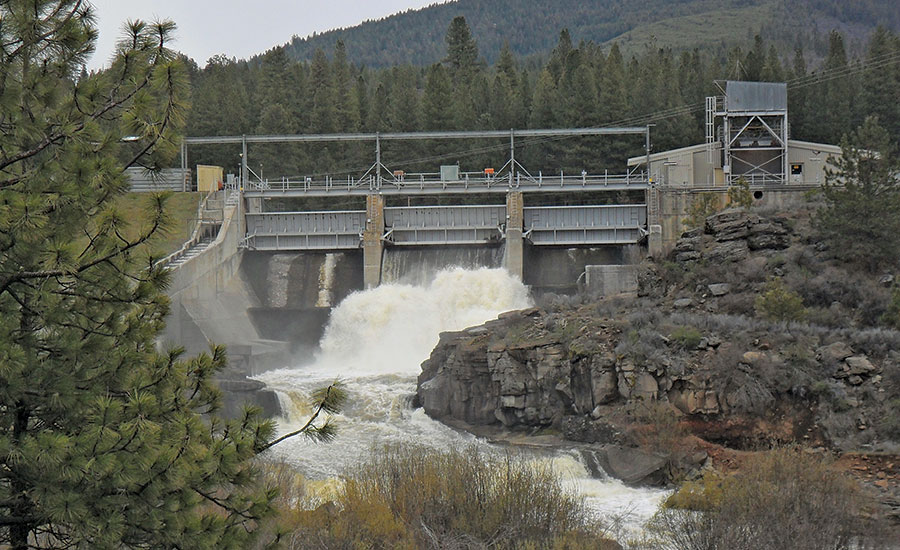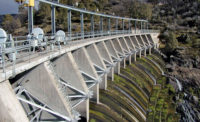Klamath Basin Stakeholders Look To Bypass Congress

After years of wrangling, the J.C. Boyle Dam—pictured here, with floodgates open to release impounded water—is one of four Upper Klamath dams that is scheduled for removal by 2021.
PHOTO WIKIMEDIA COMMONS
When the U.S. Congress adjourned in December, it scrapped a water-rights settlement package meant to end years of bitter haggling in California and Oregon’s Klamath Basin among farmers, fishermen, utilities ratepayers and environmentalists. Now, the parties have agreed to move forward on a dam-removal project under a new licensing pathway.
By way of amendments to the Klamath Hydroelectic Settlement Agreement, the U.S. departments of the Interior and Commerce, the states of California and Oregon, and utility operator PacifiCorp have agreed to remove four main-stem Klamath River hydroelectric dam facilities—Copco No. 1, Copco No. 2, J.C. Boyle and Iron Gate—through approval from the Federal Energy Regulatory Commission and in lieu of a congressional mandate.
Fighting over the river’s bounty has gone on for years. Native American tribes wanted the fish, farmers wanted the water, environmentalists wanted limits on irrigation, and the utility company wanted hydropower. Pressure from the various interests took its toll on the 700-mile river. Farms suffered in 2001, when the feds shut off irrigation water to protect endangered fish species; however, a year later, when farmers were allowed to pull from the river, a massive fish kill ensued.
“Getting a deal done on Klamath River has been a long process,” Rob Unruh, spokesman for the Klamath Water Users Association (KWUA), told ENR. “When Congress failed to act, it upended a lot of hard work [and] hard negotiations.”
Oregon’s KWUA, which represents agricultural interests, does not agree with the Dept. of Interior and PacifiCorp, which tout the recent settlement agreement as a major triumph for the dam-removal process. “There is much more to this than the dam removal, and we want what was in the original agreement,” Unruh says.
The dam removals will allow 300 miles of river to flow, once again, naturally, restoring endangered salmon runs and improving water quality. In a statement, DOI said the lower Klamath dams will be removed by 2021, but farmers could still be rationed water in drought years. With these details yet to be ironed out, old tensions could flare, Unruh says, adding, “It’s not over.”
The project highlights the growing demand for dam-removal and watershed-restoration contractors, says Jeff Szytel, founder of Water Systems Consulting Inc. and construction manager on the San Clemente Dam removal project in California. “Lots of dams that were built decades ago are filling with sediment, and some are at risk of failure. Many are barriers to fish passage, and they’ve become liabilities for their owners,” he notes.
PacifiCorp, the owner of the Klamath River dam system, plans to spend $200 million on decommissioning and dam removal under the terms of the recent settlement agreement. With all the wildlife protections required now, “it’s cheaper to decommission than relicense,” Unruh says.
Multiple trends, including a broader, growing interest in watershed stewardship and ecosystems, and an increasing number of obsolete or at-risk dams are translating into a growing need for water-services engineers and contractors.
“Doing work in the stream requires specialized skills, equipment and oversight. There are few specialty contractors [that] offer those services, so there’s room for growth there, along with a demand for firms that can manage heavy construction in a sensitive environment,” Szytel says. “Geomorphology is an engineering discipline that will be in greater demand, with expertise in sediment transit within river systems becoming more valuable, too. That’s one of the biggest challenges—managing millions of cubic yards of accumulated sediment.”
Dam-removal ventures must navigate a complex licensing process through a conglomerate of federal and state agencies, a process that requires a multidisciplinary team of engineers and contractors, Szytel says, noting Aecom’s work on the San Clemente dam project. “Even Aecom, one of the largest engineering companies in the world, had to partner with other firms to succeed on this project. A multidisciplinary team is very important, and, as you can see with the Klamath River dams, you need broad stakeholder support to lessen risk.”






